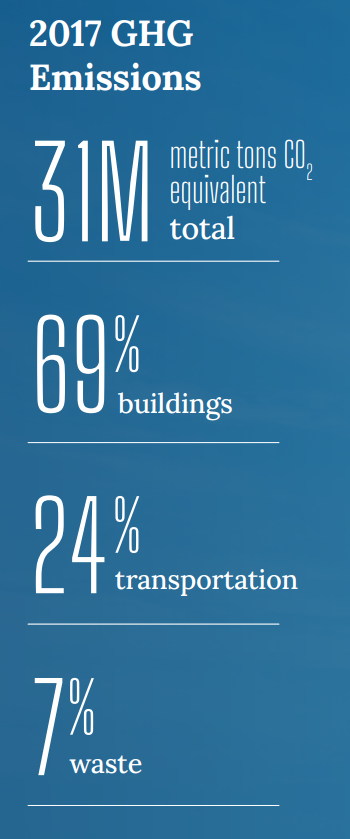Electrify Chicago
An independent tool for viewing City of Chicago building data
According to the
2022 Chicago Climate Action Plan,
69% of Chicago's emissions come from buildings, making
building emissions our biggest challenge and our biggest opportunity as a city
to tackle climate change. At Electrify Chicago, we showcase building performance using
publicly available data supplemented by community-submitted photographs and building
owners.
Start by looking at Chicago's buildings with the highest greenhouse gas intensity i.e. emissions per square foot. Large, efficient, buildings can perform much better than very inefficient small buildings on this metric.
New Article
📰 $30 Million In Missed Fines
The City Of Chicago failed to collect $30 million in potential fines from the building benchmarking ordinance, reducing transparency and accountability.
Legislative update! 🎉
As of late January 2024, legislation is being introduced to require new use more efficient forms of water and space heating, via the Clean And Affordable Buildings Ordinance (CABO), which will reduce the number of highly polluting and inefficient buildings that end up on this site.
If you're in Chicago,
write to your alderman to support the CABO!
Chicago Buildings by Greenhouse Gas Intensity
Note: Data includes large Chicago buildings with data from 2022, unless explicitly stated otherwise.
Note: This data only includes buildings whose emissions are reported
under the
Chicago Energy Benchmarking Ordinance. According to the City “As of 2016,
this list includes all commercial, institutional, and residential buildings larger than
50,000 square feet.” This dataset is also then filtered to only buildings with
reported emissions > 1,000 metric tons CO2 equivalent.
The latest year of data is from 2022, but we update the site regularly when new data is available, and some buildings may have failed to report that year, and only have older data available.
| Property Name / address | Primary Property Type |
Greenhouse Gas Intensity (kg CO2 eq./sqft) |
Total Greenhouse Emissions (metric tons CO2 eq.) |
|---|---|---|---|
|
McCabe Hall
(DePaul)
900 W Belden Ave
| College/University | 12.9 kg/sqft
Highest 7%
| 756 tons
Lowest 44%
|
|
850 W Jackson Blvd
850 W Jackson Blvd
| Office | 12.9 kg/sqft
Highest 7%
| 1,380 tons
Highest 34%
|
|
Garfield Center
10 S Kedzie Ave
| Office | 12.9 kg/sqft
Highest 7%
| 810 tons
Lowest 47%
|
|
Whitney Young -CPS
(CPS)
211 S Laflin St
| K-12 School | 12.9 kg/sqft
Highest 7%
| 5,551 tons
Highest 6%
|
|
Julian HS -CPS
🕰️
(CPS)
10330 S Elizabeth St
| K-12 School | 12.9 kg/sqft | 3,441 tons |
|
2026 N CLARK ST
2026 N CLARK ST
| Residential Care Facility | 12.9 kg/sqft
Highest 7%
| 794 tons
Lowest 45%
|
|
Advocate Trinity - POB
2301 2315 E 93rd St
| Medical Office | 12.8 kg/sqft
Highest 7%
| 657 tons
Lowest 38%
|
|
Sofitel Chicago Water Tower
20 E Chestnut St
| Hotel | 12.8 kg/sqft
Highest 7%
| 4,828 tons
Highest 7%
|
|
Glencrest Nursing & Rehab Center
2451 W Touhy Ave
| Senior Living Community | 12.8 kg/sqft
Highest 7%
| 1,083 tons
Highest 42%
|
|
2641 W Harrison St
2641 W Harrison St
| Other | 12.8 kg/sqft
Highest 7%
| 712 tons
Lowest 41%
|
|
Harmony Nursing and Rehabilitation
🕰️
3919 W FOSTER AVE
| Residential Care Facility | 12.8 kg/sqft | 825 tons |
|
Kingsbury Ctr
🕰️
1415 N. Kingsbury Street
| Strip Mall | 12.7 kg/sqft | 673 tons |
|
TRC Senior Village 1
🕰️
346 E 53rd St
| Senior Living Community | 12.7 kg/sqft | 873 tons |
|
Mahalia Jackson Apt
(CHA)
9141 - 9177 S South Chicago Ave
| Multifamily Housing | 12.7 kg/sqft
Highest 7%
| 1,159 tons
Highest 40%
|
|
Wishnick Hall
🕰️
(Illinois Tech)
3255 S Dearborn Street
| College/University | 12.6 kg/sqft | 793 tons |
Data Source:
Chicago Energy Benchmarking Data
